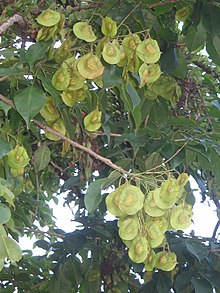Narra tree
| Pterocarpus | |
|---|---|
 |
|
| Pterocarpus echinatus seed pods | |
| Scientific classification | |
| Kingdom: | Plantae |
| (unranked): | Angiosperms |
| (unranked): | Eudicots |
| (unranked): | Rosids |
| Order: | Fabales |
| Family: | Fabaceae |
| Subfamily: | Faboideae |
| Tribe: | Dalbergieae |
| Genus: |
Pterocarpus Jacq. |
| Species | |
|
35, see text |
|
| Synonyms | |
|
|
35, see text
Pterocarpus is a pantropical genus of trees in the family Fabaceae. It belongs to the subfamily Faboideae, and was recently assigned to the informal monophyletic Pterocarpus clade within the Dalbergieae. Most species of Pterocarpus yield valuable timber traded as padauk (or padouk); other common names are mukwa or narra. The wood is marketed as amboyna when it has grown in the burl form. The scientific name is Latinized Ancient Greek and means "wing fruit", referring to the unusual shape of the seed pods in this genus.
Padauk wood is obtained from several species of Pterocarpus. All padauks are of African or Asian origin. Padauks are valued for their toughness, stability in use, and decorativeness, most having a reddish wood. Most Pterocarpus woods contain either water- or alcohol-soluble substances and can be used as dyes.
The padauk found most often is African Padauk from Pterocarpus soyauxii which, when freshly cut, is a very bright red/orange but when exposed to sunlight fades over time to a warm brown. Its colour makes it a favourite among woodworkers. Burmese Padauk (ပိတောက်) is Pterocarpus macrocarpus while Andaman Padauk is Pterocarpus dalbergioides. Padauks can be confused with rosewoods to which they are somewhat related, but as a general rule padauks are coarser and less decorative in figure. Like rosewood, padauk is sometimes used to make xylophone and marimba keys, and guitars. It is an important material in traditional Chinese furniture.
Some padauks, e.g. P. soyauxii, are used as herbal medicines, for example to treat skin parasites and fungal infections.
...
Wikipedia
